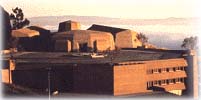 |
 |
||
 |
 |
 |
Guide for EducatorsWhy is this site important to educators, especially science educators? Glenn Seaborg’s life, work and contributions are best characterized by one word - Excellence. Science has been the central theme and Glenn Seaborg’s story, as told in His Biography, is filled with lessons for science students and educators that can be mined for personal growth, and deeper understanding, for years to come. There have been many scientists whose work has contributed to the advancement of science. Among these many are a few whose contributions have resulted in technologies that have transformed our lives. However, only few scientist’s will be recognized centuries to come because they had the ability reveal a fundamental new understanding of nature, its order and underlying structure. Glenn Seaborg is among these very few. His scientific discoveries, here in His Works, have not only touched all our lives, sometimes with literally earthshaking consequences, but they have transformed our understanding of nature. The central role of science in modern life is fully seen as it plays a central role in Glenn Seaborg’s service to the nation and in his unflagging energy and leadership for excellence in education. The realization that science could contribute to the common defense and promote the general welfare of a people and nation is modern concept to which Glenn Seaborg has been a major contributor. Glenn Seaborg’s genius is most fully revealed by his own clear explanations of the scientific principles and discoveries, by his documentation of the events surrounding his work and through his writings throughout his career. Most of the materials in this web site were written by Glenn Seaborg. What are Glenn Seaborg’s Major Contributions to Science Education?
How can I use this site for my teaching and leadership? The Seaborg Web site is a place for students and educators to explore and to create new connections to educational objectives. As a starting point the National Science Education Standards is used as an organizer for this exploration and construction. The usefulness of this approach will only be know through experimentation and feedback from you and your students. We encourage your future participation in suggesting links to the resources of this site and by developing activities for students. NSES - Introduction Glenn Seaborg was a member of the National Commission on Excellence in Education that produced the landmark National at Risk Report in 1983. You may want to learn how he became involved and his assessment of progress between 1983 and 1993. The following are the National Science Education Standards goals for school science that will educate students who are able to: What was Glenn Seaborg’s response to his first introduction to chemistry in high school? What was Glenn Seaborg doing when he first conceived of the actinide hypothesis that led to a fundamental restructuring of the periodic table and made way for the discovery (synthesis and identification of elements beyond plutonium? Suggested reading: Glenn Seaborg on Arrowsmith. What are Glenn Seaborg’s views and recommendations today on nuclear energy? Do you agree? What views did Glenn Seaborg hold regarding testing of nuclear weapons? What important contribution did he make in this area while Chairman of the Atomic Energy Commission Glenn Seaborg is the first person to hold a patent on an element. Which elements did he patent? (Hint: look at end of article). Do you agree that it is proper to grant a patent on an element? |
